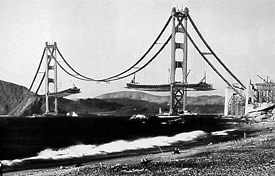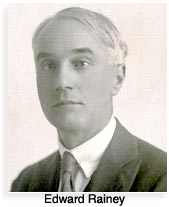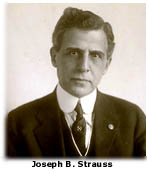|
Bridging the Golden Gate
THE STORY BEHIND THE
CONSTRUCTION OF THE SPAN
 An age-old challenge to the genius of man and engineering science has been answered in completion of the Golden Gate Bridge. An age-old challenge to the genius of man and engineering science has been answered in completion of the Golden Gate Bridge.
From time to time during the past century dreamers have suggested the feasibility of a bridge across the famous harbor entrance. In 1869 San Francisco’s own “Emperor Norton” in one of his proclamations “commanded” that a bridge be built across the Bay of San Francisco, not specifying where.
It was not until 1917 that the proposal gained real momentum. the late M.M. O’Shaughnessy, then city engineer of San Francisco, invited Joseph B. Strauss, builder of hundreds of bridges throughout the world, to tackle the problem.
Together they estimated the cost within a practical range and capacity would be $25,000,000 to $30,000,000, and concluded that the main span necessary would be at least 4000 feet.
Edward Rainey, then secretary to the late Mayor Rolph, became interested, and secured support of Supervisor Richard J. Welch, now a San Francisco Congressman.
 The following year Strauss made his original reconnaissance.
The following year Strauss made his original reconnaissance.
Welch introduced a resolution in the San Francisco Board of Supervisors August 25, 1919, providing that the City and County of San Francisco undertake preliminary surveys to furnish Strauss with information necessary for a more definitive study.
Further studies by Strauss followed, and findings were printed in a booklet issued jointly over the signatures of Strauss and O’Shaughnessy.
After lengthy studies, Strauss submitted a preliminary sketch and estimates in June 1921. The late Mayor Rolph showed his enthusiasm by issuing a call for a mass meeting at Santa Rosa January 13, 1923, to consider ways and means of carrying the project forward.
Representatives of 21 counties attended, and the Bridging-the Golden-Gate Association was formed.
A bill was introduced in 1921 in the California Legislature, creating an incorporated bridge district to finance, construct and operate the project as a public toll bridge. State Assemblyman Frank L. Coombs of Napa was author of the bill, which became a law the same year, and was amended in 1925 and again in 1931.
In the spring of 1924 San Francisco and Marin Counties made a joint application to the government for a permit to bridge the Golden Gate.
The Army Engineers held a hearing in San Francisco May 16, 1924.
On December 20, 1924, Secretary of War John W. Weeks notified the committee of the War Department’s approval of the project. Actual incorporation of the Golden Gate Bridge and Highway District was delayed by litigation instigated by opposing interests until December 1928.
Board of Supervisors of the various counties whose citizens had voted to become a part of the District appointed directors who held their first meeting January 23, 1929, and organized.
 Proposals were invited from eleven of the Nation’s leading bridge engineering firms. After an analysis Joseph B. Strauss of Chicago was selected on August 15, 1929, as chief engineer, Leon Moisseiff and O.H. Ammann of New York and Prof. Charles Derleth, Jr., of the University of California were named as consulting engineers.
Proposals were invited from eleven of the Nation’s leading bridge engineering firms. After an analysis Joseph B. Strauss of Chicago was selected on August 15, 1929, as chief engineer, Leon Moisseiff and O.H. Ammann of New York and Prof. Charles Derleth, Jr., of the University of California were named as consulting engineers.
The engineering board met in San Francisco shortly afterwards and determined upon the basic design of the bridge. Subsequently, in accordance with provisions of the bridge act, a three cent tax was levied on taxpayers and later a two cent tax. This was used to cover preliminary engineering, legal and other work.
A field staff was organized by Strauss and specifications made for diamond drill borings to determine conditions for piers and anchorages...
On February 12, 1930, the engineering board met and passed on borings and presented them to the board of directors with a preliminary report of the geologist, Prof. Andrew Lawson of the University of California.
On April 15, 1930, application was made to the Secretary of War for approval of the approach road plans through the two military reservations.; On May 1 application for approval of the bridge clearances for navigation were filed.
Shipping interests asked a special hearing on the clearances, which were held by the Army Engineers June 30, 1930. On August 11 the same year the War Department issued the final permit fixing the clearances.
In November 1930, the proposal for a $35,000,000 Bond issue was submitted to the voters of the counties comprising the district, and the issue carried overwhelmingly. Bidding plans were prepared, and first bids received in July 1931. A taxpayers suit followed before the word was awarded, and a final court decision favoring the district was given in July 1932.
On January 5, 1933, actual construction of the Bridge was begun.
IN: Official Program; Golden Gate Bridge Fiesta
1937
Return
to the top of the page.
|